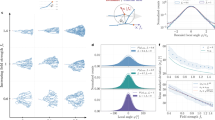Abstract
Recently three branching modes were characterized during the formation of the lung in mice. These modes are highly stereotyped and correspond to domain formation, planar bifurcation and three dimensional branching respectively. At the same time it is proved that although genetic control mechanisms are presumably related to the selection of any of these modes, other external factors will most probably be involved in the branching process during development. In this paper we propose that the underlying controling factors might be related to the rate at which the tubes that form the lung network grow. We present a mathematical model that allows us to formulate specific experimental predictions on these growth rates. Moreover we show that according to this formulation, there is an optimization criterion which governs the branching process during lung development, namely, efficient local space filling properties of the network. If there is no space limitation the branches are allowed to grow freely and faster, selecting one branching mode, namely, domain formation. As soon as volume constraints appear the growth rate decreases, triggering the selection of planar and orthogonal bifurcation.
Similar content being viewed by others
References
M. Benítez, E. Álvarez-Buylla, C. Espinosa, P. Padilla-Longoria, Int. J. Dev. Biol. 51, 139 (2007)
A. Litta, E.M. Kramer, The Seminars in Cell Develop. Biol. 21, 129 (2010)
R.J. Metzger, O.D. Klein, G.R. Martin, M.A. Krasnow, Nature, 453 (2008)
W.M. Ni, Notices AMS 45, 9 (1998)
A.D. Peel, A.D. Chipman, M. Akam, Nat. Rev. Genet. 6, 905 (2005) doi:10.1038/nrg1724
C. Garza-Hume, P. Padilla, Electron. J. Differential Equations, Conference 15, 97 (2007) ISSN: 1072-6691. URL: http://ejde.math.txstate.edu
R. Plaza, F. Sánchez-Garduño, P. Padilla, R.A. Barrio, P.K. Maini, The effect of growth and curvature on pattern formation, Preprint no. 64 (2004)
Author information
Authors and Affiliations
Corresponding authors
Rights and permissions
About this article
Cite this article
Alarcón, T., Castillo, J., García-Ponce, B. et al. Growth rate and shape as possible control mechanisms for the selection of mode development in optimal biological branching processes. Eur. Phys. J. Spec. Top. 225, 2581–2589 (2016). https://doi.org/10.1140/epjst/e2016-60032-0
Received:
Revised:
Published:
Issue Date:
DOI: https://doi.org/10.1140/epjst/e2016-60032-0




